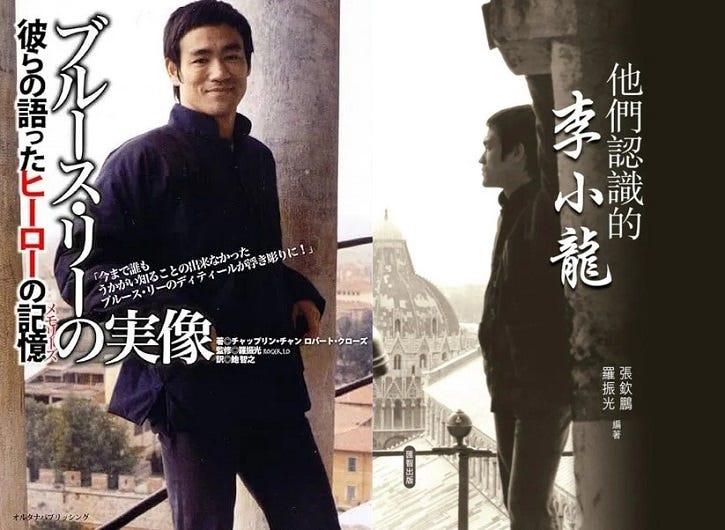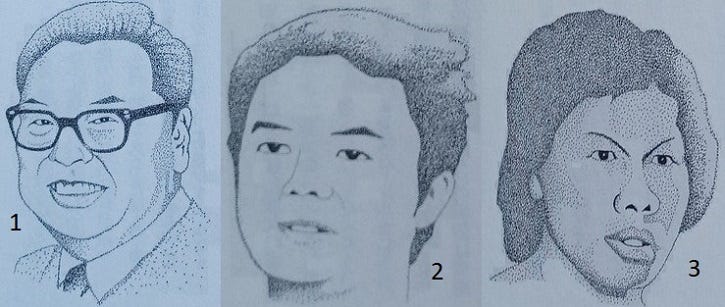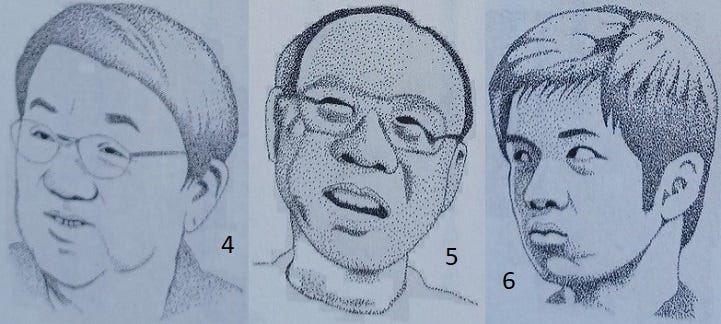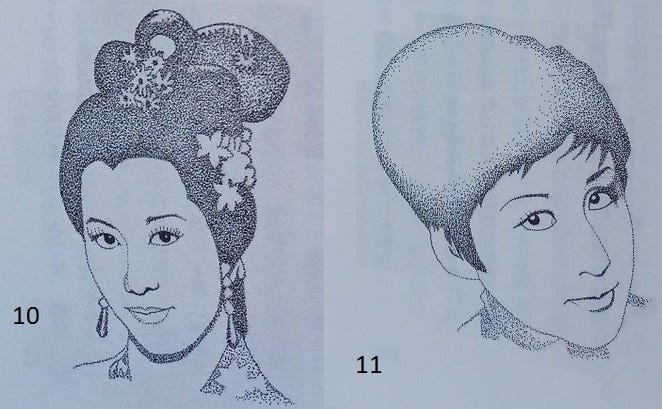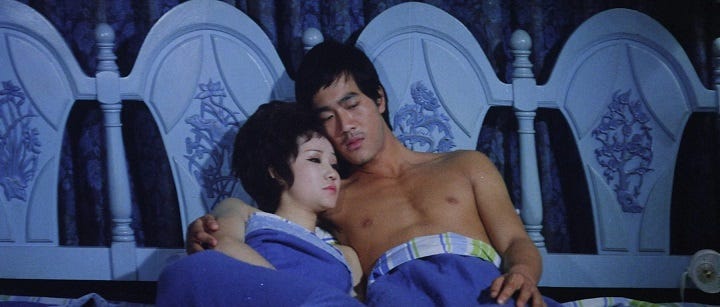Robert Clouse must have been turning in his grave (if he was not cremated). Inside Kung Fu’s Dave Cater was the editor of Clouse's Bruce Lee: The Biography (1988). The IKF magazine was published by CFW, who also published a magazine called Martial Arts Movies. In August 2005, CFW were acquired by Apprise Media. Near the front of Grace Lee's Bruce Lee: The Untold Story (1980), there is a statement at the bottom of the page: “Bruce Lee: The Untold Story is a special publication of CFW Enterprises. Copies may be purchased through Unique Publications.”
Besides the book written by Bruce’s mother, Unique published Robert Clouse’s The Making of Enter the Dragon (1987). About a challenger named Wong Jack-Man, Clouse wrote in the biography: “Many years later, after the story of the Wong fight had been told and retold in print, Wong claimed his character had been defamed and he had been held up to ridicule, which caused harm to his teaching of the martial arts. He sued Linda Lee, Danny Inosanto, and CFW Enterprises, Inc., for in excess of $1 million including punitive damages. The case was argued for two years before finally being dismissed. Many people would be proud to say they fought and lost to Bruce Lee.”
Ironically, Linda Lee's The Bruce Lee Story (1989) was published by Ohara Publications (who began in 1966 and were dissolved in 1999). In the book, Wong is only referred to as the challenger. Ohara also published The Tao of Jeet Kune Do, Bruce Lee's Fighting Methods and The Incomparable Fighter (1988). Ohara are the same people behind the Fighting Stars magazine. Ohara shared the same address as Rainbow Publications, which published the Black Belt magazine. Linda’s decision to have a second book is suspect because it’s mostly a reprint of her 1975 book (Bruce Lee: The Man Only I Knew) i.e. with some revisionist editing. If Bruce’s widow didn’t like the first book then she could have come out with a remake way before Clouse published his books on Bruce. Her timing is suspicious because the research that Clouse had conducted was allowed to be published in its uncensored glory for the Chinese and Japanese markets, albeit in 2013 and 2014 respectively.
The Chinese edition was titled The Bruce Lee They Knew whereas the Japanese edition was titled The Real Bruce Lee: Memories of a Hero. When Clouse was interviewing Bruce’s associates in Hong Kong, his translator was Chaplin Chang - assistant director on Enter the Dragon and production manager for The Way of the Dragon (Bruce’s directorial debut). The 21st century book was done with the assistance of Lee biographer Roger Lo Chun-Kwong, albeit Chaplin had the copyright to publish the Chinese version of Clouse’s research ever since the eighties. The Chinese book was published in July 2013 - the month that marked the 40th anniversary of Bruce’s death. More specifically, it was published on the twelfth day of that month - the 40th anniversary of when Bruce had used a knife to threaten the magazine editor of the Golden Harvest film company. Spookily, it would appear that the book was only published because Robert Chan died in July 2012 (the year of the dragon). Let’s just say that Robert had some dodgy connections.
The timing of the publication was far from circumspect because 2013 was when photographer Dave Friedman had published Enter the Dragon: A Photographer's Journey. Another point of symmetry is that Chaplin was 87 years old in 2013 whereas the interviews were conducted in 1987. 1986 would have been an even better year to interview people because that’s when Brandon Lee went to Hong Kong to make Legacy of Rage. A point of consolation can be found in the fact that Brandon may have been used by Clouse to test the waters regarding who was okay with being interviewed, or who was being honest. A point of contention can be found in the fact that some of the people mentioned in the book had already died by 2013 (the year of the snake in the Chinese zodiac). Chaplin Chang’s excuse was: “As time passes, memories fade or become distorted. People gave more accurate accounts about Lee 20 years ago. Now fans glorify him.”
The above and below illustrations come from the Japanese edition that I purchased two weeks ago. The eleven people interviewed were director Lo Wei (1), childhood friend Robert Chan (2), bodybuilder Bolo Yeung (3), childhood friend Michael Lai (4), ETD cameraman Henry Wong (5), ETD actor Stephen Tung (6), ETD cameraman Charles Lowe (7), ETD actor Roy Chiao (8), ETD assistant director Chaplin Chang (9), actress Pak Yan (10) and actress Betty Ting Pei (11). The first three people who were interviewed could be considered a Triad in both the triangular and mafia sense. In fact, Bolo Yeung was interviewed in the presence of fellow bodybuilder Robert Chan. Lo Wei was a high-ranking member of the Sun Yee On Triad, Robert was on close terms with Triad members, and Bolo was a Triad enforcer. As such, I will reveal the things that didn’t get mentioned in the English language edition of Robert Clouse’s biography. One time, Bruce asked Lo if he had an English name, to which Lo joked that it was DDT (an organochlorine insecticide).
When Bruce Lee returned to Hong Kong after filming The Big Boss in Thailand, he reunited with Robert Chan. Upon doing so, he learned that Robert was working as an instructor at a bowling alley. The aforementioned magazine editor, Dave Cater, once conducted an interview with Jackie Chan where Jackie told him about how he once took Bruce to a bowling alley in the final month of his life. Robert was disingenuous about Bruce having an acting career before he left Hong Kong for the U.S. in 1959. It’s like Robert wanted no part in it, maybe because the Triads have always been a fixture of the Hong Kong film industry whether it be demanding protection fees or simply being cast. If Bruce could get challenged when making movies as a grown-up then why not when he was an adolescent actor, especially since he was notorious for getting into fights on streets.
With the obvious exception of Robert Baker, the most glaring omission from Clouse’s biography is Wu Ngan. Robert Chan said: “There was a man named Wu Ngan who was the son of a servant at the Lee family. He worked from a young age and didn't go to school. He ran a tailoring shop in Kowloon. After Bruce went to America, he somehow went to England to work. When Bruce came back to Hong Kong, he contacted Wu Ngan and asked him to come back to Hong Kong. After that, Ngan worked for Bruce. Bruce asked him to do a lot of things. Ngan was a timid man and kept his mouth shut, so Bruce trusted him. When he and Ngan did something, they sometimes kept it a secret from us. He is now living happily in England.”
Being a journalist is like being a policeman. Lo Wei, Robert Chan and Bolo Yeung were interviewed on the same day - January 15, 1987. There is an interview technique where you ask someone about something that you already know, either to test their honesty or to see how commonly known that something is. Robert Chan made it clear in his interview for Chaplin Chang that there were things that he knew about Golden Harvest and Bruce Lee’s personality which he didn’t want to talk about. With this in mind, I should address that Chaplin asked Robert if Bruce talked to stuntmen at a restaurant, to which Robert pleaded the fifth by saying: “I couldn’t say.”
As for the interview with Bolo Yeung, self-censorship can be as much to do with the interviewer as the interviewee. He talked about meeting up with Bruce, Raymond Chow and George Lazenby at a restaurant. However, Robert Clouse didn’t incorporate this into his Bruce Lee biography because Bruce referred to Lazenby as “no-one special” when Bolo asked him who he was going to have dinner with at the restaurant. While there was talk at dinner of the “Australian 007” potentially appearing in a Hong Kong film, The Game of Death was not cited. Either way, Clouse didn’t believe that Bruce was interested in making a movie with a one-off Bond when he had his sights set on working with much bigger stars (according to Betty Ting Pei).
This trifecta are decidedly safer folk. Michael Lai was interviewed in mid-November 1987. Henry Wong was interviewed on January 16, 1987 before Stephen Tung was interviewed on January 17. Michael had some goodies to share that weren’t imparted by Clouse in his biography. When Bruce came back to Hong Kong for the first time after leaving for America, he took Lai to a place called Shanghai Bathhouse for the first time. After that, Lai learned the cha-cha from Lee. Disregarding the gay subtext, Michael Lai let it be known that Bruce was flirting with a woman who would later become an actress and singer - Sally Chen Sha-Li. Her mother, Patsy Chen Pak-Sai, worked at the American consulate. When talking about Bruce as a school kid, Michael specified that Bruce got into one-on-one fights but not group fights (implying that times would change).
Chaplin Chang proved to be on equal footing with Michael with his knowledge of Bruce’s older brother, Peter - a Hong Kong government official who was unseemingly untouchable by the police. Chang and Clouse told Michael that Bruce’s entourage consisted of stuntmen. Chang wanted to know from Michael what Bruce drank when they went to nightclubs, restaurants and coffee shops. Michael claimed that Bruce didn’t drink alcohol but he couldn’t remember what he drank. Chang revealed that doing research for Clouse’s book projects was difficult because the stuntmen were so busy. Lam Ching-Ying was singled out, but that’s more likely because he became a movie star in his own right instead of being closer to Bruce than the others (e.g. Bruce’s stunt double Yuen Wah).
Despite how busy that the stuntmen were, Chaplin and Clouse were not put off from the prospect of wanting to interview Jackie Chan in spite of the fact that he was bigger than all of Hong Kong’s stuntmen put together. It was stated in Henry Wong’s interview that it was the night of Bruce’s death when Henry got a phone call from someone at Golden Harvest asking him for the extra hours of production footage from Enter the Dragon. Also, Henry claimed that everyone has remained tight-lipped about Bruce giving HK$20,000 to the mother of an injured extra who challenged him on the set of Enter the Dragon. The clue to the secrecy is that Bruce didn’t mind paying that much. Lying by omission can be found in another anecdote - Bruce offering to pay replacements of the dead birds for the birdcages in the banquet scene.
Robert Clouse was so annoyed about not getting his bonus residuals from the release of Enter the Dragon that he didn’t reveal in either of his books about his intention to do a sequel where the main character was the disciple of the Lee character. Stephen Tung could have done a sequel where he teams up with Sammo Hung, who was also in the first reel of Enter the Dragon. As for exclusive Bruce trivia, Stephen said: “He would often sing and drink with Lam Ching-Ying and us. He used to come to the Huayuan Building a lot in those days. Lam Ching-Ying and others lived there. When he had a fight with someone, I wasn't there most of the time. At that time, Lam Ching-Ying and the others were older than me, so when they went out to play, I was left behind.”
As for this triumvirate, Charles Lowe was interviewed on January 18, 1987. Roy Chiao was interviewed on January 19 whereas Chaplin Chang was interviewed by Robert Clouse on January 20. Charles said something that reminded me of things that were said by Andre Morgan and Yuen Bun. Basically, Bruce was at the Golden Harvest film studio on the morning of July 20 - the day that he was declared dead. His presence at Golden Harvest that day has always been the elephant in the room because the official story is that he was only at his house before going to Betty Ting Pei’s apartment. Lowe’s last memory of Bruce took place around noon. As Charles was about to leave Golden Harvest, he was under the impression that Bruce wanted to discuss something with Raymond Chow. More controversially, Charles remembered going to Bruce’s house around six in the evening where he saw Unicorn Chan and other movie stars as they stared into space. No-one would tell him where Bruce was. This obviously conflicts with the official story that was told by Linda Lee and Raymond Chow.
Way more damningly, there was a consensus reached in the 1987 interview that not only was Bruce and Linda headed for a divorce but he didn’t intend to make more movies for Raymond. He was also thinking about only doing two more movies as an actor before focusing on producing. He supposedly had already signed a contract with a Hollywood company, but Charles didn’t know which one. Bruce’s next movie after Enter the Dragon was going to be another collaboration with Clouse but one that was “more Chinese” - this would only be possible if Bruce wanted Clouse to direct him in the dynasty project for Shaw Brothers. Had this happened, Robert would have gained the distinction for being the first American to direct a Hong Kong film much like how Bruce became the first Hong Kong movie star to lead a Hollywood film. As for July 20, Charles asked Bruce if they could have dinner that night but Bruce said he was busy and he would call later on…but he never did. Unlike Andre Morgan and George Lazenby, Charles and Yuen Bun didn’t say anything about Bruce complaining of a headache.
Roy Chiao, like Bruce Lee, used to be into bodybuilding when he was younger. Roy was someone who prepubescent Bruce looked up to in that regard. Like Charles Lowe, Roy was a devout Christian. Charles tried to get Bruce to attend church, but he wouldn’t have it. Shih Kien, a fellow actor from Enter the Dragon, went to the same bible study group as Roy. This was Hong Kong Artistes Christian Fellowship, formed in 1985. Like what Bob Wall said decades later, Roy’s first thought when he heard that Bruce died was that it must have been a car accident (especially since Bruce died during a time when owning a sports car was trendy). Chaplin Chang told Clouse that Andre Morgan was obsessed with cars, and boasted that he never had an accident no matter how fast that he drove. I should save the best till last, so I will write about Chaplin’s interview (the longest one) much later on. The below duo could have been a trio had Nora Miao been interviewed.
Pak Yan was referred to in the Japanese edition of the book as Amy Chan. Her birth name is Chen Hui-Hsien. The interview date was January 1987. Perhaps Betty Ting Pei was interviewed last so that she was placed under a lot of pressure. A person who tries to conceal can be just as informative as someone who tries to reveal. You can learn something from someone who tries to turn the tables on you by inquiring you about your research. It’s a classic case of deflection and projection. Going back to Amy, she potentially could have been in an affair with Bruce. In 1963, they spent five months together. She recalled telling him in 1971 that she was married. This was the year when he had returned to Hong Kong. Bruce had a tendency to forget his wife’s birthday, but he would never have forgotten Amy’s because her birthday was three days after his. Adding to the drama is that Unicorn Chan used to have dim sum with Amy without Bruce, but she ended up getting more intimate with Bruce.
In Hong Kong, an evasive person is described as using Tai Chi. As such, politicans are described as Tai Chi masters. Betty Ting Pei’s interview is notable for how she didn’t say anything about Bruce’s final day. Either she told Chaplin Chang and Robert Clouse that she wouldn’t talk about it, or maybe they didn’t bother because they knew that it was a fabricated story that was concocted by Raymond Chow to help sell Bruce’s shelved 1972 project - The Game of Death. I don’t want to use this article as a Pandora’s box, so I will recommend that you check out my Medium articles - Bruce Lee’s Final Week along with How and When Bruce Lee Died. What I will say is that there is a phone call with Davis Miller that was used for the audio commentary of Toby Russell’s Death by Misadventure where Dr. Donald Langford speculated that Betty’s involvement with Bruce’s final day was a fabrication to increase her publicity. The Sing Hoi company, who Bruce wanted to sue, were making a movie featuring Betty when he died.
As for the interview in 1987, Betty didn’t come off well. She was initially in denial about his tantrums. She also found difficulty in answering whether he was nervous during filming or at the end of filming. Making matters more awkward is that Chaplin asked her if she recalled Bruce admonishing someone by calling them a retard or a mother-related expletive. Elsewhere, Betty recalled that one of Bruce’s future plans was to star in a Kung Fu Western. While he seemingly never told her about what happened with the Kung Fu TV series or even The Green Hornet, she recalled him referencing The Silent Flute many times. At one point, she says “some kind of flute” which I have taken to mean that Bruce would use the title as a metaphor (i.e. perhaps for his manhood). Betty was seemingly unaware of any secrets that he had disclosed to her. If she really was his mistress, she would have known if he had intended to divorce his wife - Linda Emery. On the subject of divorce, Warner Brothers president Ted Ashley divorced his wife in 1973. This woman, Linda Palmer (seen below), married Sy Weintraub on Valentine’s day of that year.
The significance being that Bruce’s July 20 letter to his attorney (Adrian Marshall) had referenced the prospect of doing business with Sy but not Ted. In fact, Ted phoned Palmer to inform that Bruce had died. Let’s move on to another Ted - Thomas. He wrote a 1989 book about how to deal with the media (I Was Misquoted). This Ted was a colleague of Golden Harvest and worked as a publicist for the police, so Betty could have needed his help when the time came to be interrogated by the police in 1973. That 1973 Sing Hoi film that Betty was acting in, The Chivalrous Knight, began with a featurette, The Last Day of Bruce Lee, containing narration by Ted. That’s surreal by itself but the schizophrenic music, including a lullaby melody, when combined with the polar-shifting imagery only adds to the quirkiness and the eeriness. It’s a short that Federico Fellini and David Lynch couldn’t have concocted. The only thing missing from the bizarreness is the fact that Bruce knew two men (Bob Baker and James Coburn) who had wives named Beverly.
Bruce’s B-initialed bedtime babe, Betty, was asked by Chaplin Chang what his favourite colour was. She claimed that he liked blue. This would explain the below biopic, Super Dragon (1974). In the nineties, Bolo claimed that he was going to write an unconventional book about him which would include original facts such as what his favourite colour was. Bruce didn’t drive a blue car or have a preference for blue clothes. It didn’t even play a prominent role in the films that he had directed, but Robert Clouse told Chaplin about something that he observed in Bruce’s house: “The lights on the second floor are blue. Strange, right? Blue light is bad for humans. Warm colours like yellow are good for the body. Blue made me feel uncomfortable every time I saw it. I don't know why they used that colour. Those lights were on most of the time. I've been in that office upstairs a lot when I was revising the script with him!”
Four years ago, a bunch of letters from Bruce and Linda Lee to Bob Baker found their way onto an auction site. Among the dozens of letters was the revelation that Bruce was not only taking cocaine but selling it. Baker sent drugs addressed to Wu Ngan at Golden Harvest. Since cocaine consumption can result in sensitivity to light, it would make sense to use blue lights since they are less harsh. Before I finish, I should inform you that Chaplin Chang had been a colleague and friend of Raymond Chow for many years before he got involved with Bruce’s dragon films. Therefore, Chaplin has a blind spot. Although he wanted people to know the real Bruce Lee, he refused to tell Clouse about a situation involving the men who played the prisoners in Enter the Dragon. During their interview, Clouse said: “There were some good people in there. Once they were making a fuss about Bruce and I asked you why but you said - I can't tell you what they're saying.”




